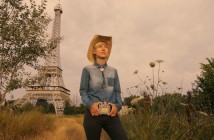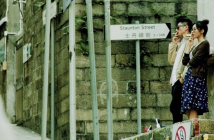Editor’s Note: The following review is part of our coverage of TIFF’s winter film series Magic Motion: The Art of Stop-Motion Animation. For more information, visit tiff.net and follow TIFF on Twitter at @TIFF_NET.
Sir Arthur Conan Doyle may be best known for his immortal creation Sherlock Holmes, but he also created the mythos of an area of the earth untouched by evolution or extinction, a land where dinosaurs still roam the earth. It was natural that Hollywood would try to translate this novel into film and in 1925, Harry O. Hoyt did just that with the help of Willis O’Brien, the man who later revolutionized special effects when he did the stop-motion work on King Kong eight years later.
Willis O’Brien created some sequences that are still thrilling 90 years later. It’s amazing that in the age of hyper-realistic CGI that something this basic can still look so good, but it is a testament to O’Brien’s superlative craftsmanship.
The story of The Lost World (1925) is incredibly simplified, especially for a late-era silent film. It revolves around Ed Malone (Lloyd Hughes), a young newspaper man whose fiancée Gladys (Alma Bennett) says she won’t marry anyone who hasn’t faced danger and stared down death. This leads Ed to request a dangerous assignment and he’s enlisted to sneak into a lecture being given by Professor Challenger (the great Wallace Beery) who claims to have discovered a plateau in South America where dinosaurs still lived. This causes him to be ridiculed by the scientific community. At the lecture, Ed gets in via a friend, Sir John Roxton (Lewis Stone). Challenger refuses to lecture, rather he challenges those there to come with him to verify his find.
 Ed wants to go after Sir Roxton and Professor Summerlee (Arthur Hoyt) say they’ll go. Ed volunteers but is chased out because he is a reporter (Challenger has taken to physically accosting reporters since his return). Undaunted, Ed follows Challenger home and pleads his case that he wants to go so his fiancée will marry him. Here he learns of the true nature of the plateau and the expedition: to rescue Paula White’s (Bessie Love) father who was lost on the prior journey. Ed says it would be a good human interest piece and his paper will fund the rescue mission.
Ed wants to go after Sir Roxton and Professor Summerlee (Arthur Hoyt) say they’ll go. Ed volunteers but is chased out because he is a reporter (Challenger has taken to physically accosting reporters since his return). Undaunted, Ed follows Challenger home and pleads his case that he wants to go so his fiancée will marry him. Here he learns of the true nature of the plateau and the expedition: to rescue Paula White’s (Bessie Love) father who was lost on the prior journey. Ed says it would be a good human interest piece and his paper will fund the rescue mission.
With that, they are off, with Ed telegraphing story snippets back to his London office. Once they arrive at the plateau, the film really gets going. Now we see O’Brien’s excellent, if primitive, stop motion work. The dinosaurs are not well integrated into the live action due to technological limitations; since O’Brien had to invent a lot of the forced perspective, matte painting integration and rear-projection work that was done in King Kong eight years later, what we get in The Lost World is cutting back and forth from live action to stop-motion.
Even with those limitations, the sequences with the dinosaurs, mostly fighting one another, is what the film is famous for, and rightfully so. O’Brien’s work brings the dinosaurs to life in magnificent fashion. The work isn’t as detailed as one would expect now, but for its day it was revolutionary. Keeping mostly to long shots so there isn’t much need for nuance in the texture and facial movements of the animals, O’Brien created some sequences that are still thrilling 90 years later. It’s amazing that in the age of hyper-realistic CGI that something this basic can still look so good, but it is a testament to O’Brien’s superlative craftsmanship.
The rest of the film is good but hardly worth the trouble without O’Brien’s effects. Beery gives a blustery performance, the silent version of what he would later become known for in sound pictures like Grand Hotel and The Champ (for which he won an Oscar in 1931) and is incredibly entertaining to watch. Stone also gives the kind of performance he would be better known in sound films for, very upright and noble, even sacrificing. Love’s performance is all eyes, but she does get her emotions across well, if a little too overwrought at times.
The film moves at a rapid pace and the cutting between close, medium and long shots are timed so well that it makes the otherwise lackluster live-action bits move with some degree of urgency.
Hoyt’s direction is fairly unremarkable, especially given the time. By this point, silent films had gotten extremely creative with camera placement and movement, but Hoyt seems locked into the older style, when the camera still had to be cranked so you just planted it on its tripod and let it run. His framing is standard and unimaginative, choosing to hinge the entirety of the live-action sections on the acting, which isn’t a terrible decision, but one that wasn’t necessary given the potential to be a little showier with the camera.
What saves the live-action stretches is the succinct and quick pacing of the editing, done by George McGuire (who would later bring his pacing expertise to the great film noir Detour). The film moves at a rapid pace and the cutting between close, medium and long shots are timed so well that it makes the otherwise lackluster live-action bits move with some degree of urgency.
One thing should be noted about the length of the film, while on the subject of editing. Beware of shortened prints that have circulated over the years. The restored version is around 90 minutes and it is believed that this is the closest that we’ll get to what the original cut looked like. The most common print for years ran about 60 minutes, but various others ran anywhere between the 60 and 90 minutes. Make sure you get the full(est) version when watching the film, otherwise the experience will seem anemic and incomplete.
A troubling note should also be brought up, and that is the use of blackface. The guide, Zambo (Jules Cowles), is a white man in blackface. The practice was commonplace back then and some directors (like the legendary D.W. Griffith) wouldn’t allow black actors in the same scenes as white actors. Knowing that doesn’t make watching it any easier and I wish that the part of the guide would have been filled by an actual person of color or at the very least the part be rewritten to be a white man who contracts himself to European explorers as a guide. The blackface isn’t as garish as it was in the old minstrel shows, emphasizing the lips, eyes and teeth, but it’s still there and painfully obvious.
Even with its faults, The Lost World is still an incredibly entertaining film and one that should be watched more for Willis O’Brien’s stop-motion dinosaurs than for the actual story, but the story isn’t bad either. It is also interesting to see this silent precursor to King Kong in both tone and story. With that in mind, and the fact that it’s a solid picture in and of itself, The Lost World is definitely worth a look.
A fascinating example of late silent-era filmmaking, The Lost World is an incredibly entertaining film thanks to Willis O’Brien’s stop-motion dinosaurs and special effects.



